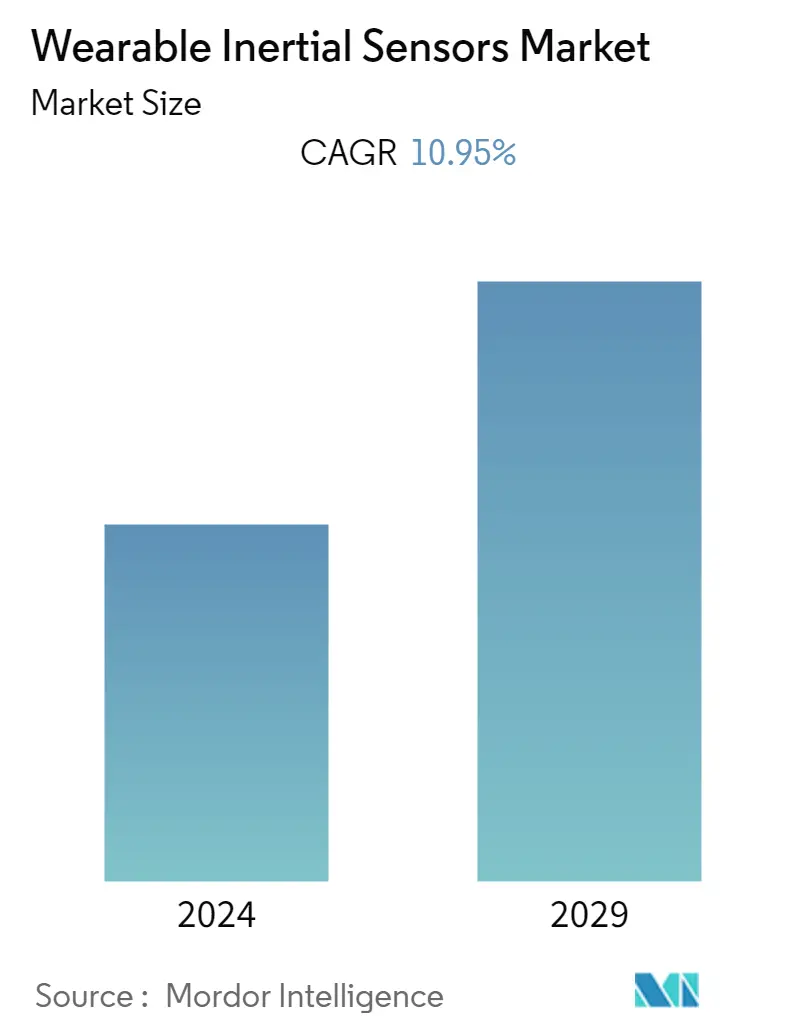Market Size of Wearable Inertial Sensors Industry

| Study Period | 2019 - 2029 |
| Base Year For Estimation | 2023 |
| CAGR | 10.95 % |
| Fastest Growing Market | Asia Pacific |
| Largest Market | Asia Pacific |
| Market Concentration | Low |
Major Players
*Disclaimer: Major Players sorted in no particular order |
Need a report that reflects how COVID-19 has impacted this market and its growth?
Wearable Inertial Sensors Market Analysis
The wearable inertial sensors market was valued at USD 629.05 million in the previous year and is expected to attain a CAGR of 10.95%, reaching USD 1.165 billion by the next five years during the forecast period. Wearable inertial sensors, also known as inertial measurement units (IMUs), are electronic devices designed to measure motion-related parameters using one or more accelerometers, gyroscopes, and magnetometers. These sensors are small, lightweight, and can be effortlessly worn by individuals to track their movements during daily activities. Wearable inertial sensors, including gyroscopes, accelerometers, and magnetometers, have developed considerably during the last decade. Through performance, miniaturization, and cost drop, wearable inertial sensors have been integrated into several daily life products, such as smartphones and smartwatches.
- The fields of application of wearable inertial sensors are numerous. For instance, activity monitoring and fitness tracking are widely employed in the consumer market. Various medical applications based on signal data from wearable inertial sensors have been developed, including fall risk assessment, fall detection, and early identification of Parkinson's disease. According to the Parkinson's Foundation, in 2016, the estimated number of Parkinson's disease patients was around 1 million. This number is predicted to increase to approximately 1.8 million by 2030. Such developments raise the demand for the market studied.
- The rising urbanization across the globe has significantly driven the demand for advanced, aesthetically appealing consumer electronic products that can better serve the consumers' requirements, such as portability, multiple features in one device, and compact and time schedules. Moreover, in recent years, a sizable number of millennials globally has been quick to adopt wearables of different types, including smartwatches, owing to the increased disposable income and the growing penetration of digital solutions.
- Wearables are further witnessing a surge in adoption among the older age population, as most wearable device providers, including Apple, Samsung, and Fitbit, are integrating advanced health-monitoring features that keep them updated about their health status in real time. Considering the growing demand for healthcare wearables, new players are continuously marking their presence in the studied industry by launching innovative solutions, which are also positively impacting the growth of the market studied.
- However, the high cost of wearable products and stringent regulatory compliances across developed regions are challenging the studied market. Furthermore, interoperability concerns owing to the lack of common global standards are also anticipated to remain among the major factors restraining the growth of the studied market.
- The COVID-19 outbreak impacted the growth of the studied market. Owing to the pandemic, the demand for personal health tracking devices increased significantly, driving the demand for wearable devices. With the trend anticipated to sustain in the post-covid period owing to the efforts of the industry players to make these devices as lifestyle products, the studied market is anticipated to witness notable growth in the post-covid period as well.
